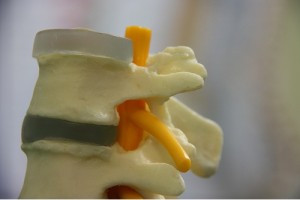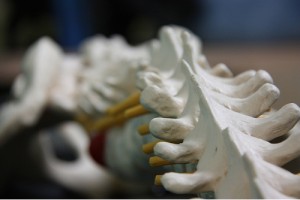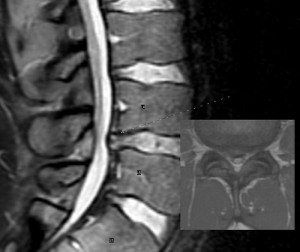Artificial Disc Replacement is basically an implant that is used to replace a worn out or diseased intervertebral disc. The artificial disc is a metal or plastic prosthesis. Until the recent past, the surgery was more popular in Europe than in the United States. Artificial disc replacement surgery is at present confined to the lumbar spinal region – which is the lower section of the spine.

When Does Artificial Disc Replacement Become Necessary?
The intervertebral disc is located between each pair of vertebrae and functions as the body’s shock absorber. A healthy intervertebral disc helps protect the spine during activities like running, jumping and lifting. Once the intervertebral disc starts degenerating, the two vertebras come closer to each other.
Damage to the intervertebral disc also affects structures like the facet joints. The end result is damage to the articular cartilage which leads to arthritis. The reduction in height between the vertebrae plus arthritis can also affect nerve endings that get squeezed, leading to crippling pain.
Sometimes, a tear in the intervertebral lumbar disc causes its soft inner portion to spill out. This tear will release chemical mediators into the body that can cause severe pain. This condition is known as a herniated disc or a slip disc and is also an indicator for artificial disc replacement.
The Artificial Disc Replacement Procedure

The surgery is done under general anesthesia. An incision is made near the umbilicus and the damaged intervertebral disc is removed using special instruments. The surgeon will then restore the height between the two vertebras which had reduced due to the collapse of the lumbar disc.
Once the vertebras are restored to their original position, the artificial disc is inserted. The incision is then closed with special surgical glue. The entire procedure takes two to three hours.
The Different Types of Artificial Disc

There are two kinds of surgery that can be performed. These are broadly classified as total disc replacement and disc nucleus replacement. In total disc replacement, almost the entire disc is removed, while in disc nucleus replacement, only the central part of the disc is replaced with prosthesis.
There are also disc replacements that are used to replace damaged discs in the cervical area. However, these are not yet approved for use in the United States though studies are being conducted.
The Benefits of Artificial Disc Replacement
Prior to artificial disc replacement, spinal disc fusion surgery was used to treat degeneration of the lumbar disc or herniated disc. Spinal fusion surgery meant that the two vertebrae were fused together using a bone graft. However, the problem with spinal fusion surgery was the resultant loss in motion.
In the long run, spinal fusion also resulted in extra stress on adjacent vertebrae. Artificial disc replacement surgery does provide good pain relief without compromising on mobility. It also does not place any extra stress on adjacent vertebrae. However, the long term impact of artificial disc replacement is yet to be assessed.
The artificial disc replacement surgery involves a two to four day hospital stay as well as physical and occupational therapy for complete disc replacement recovery.